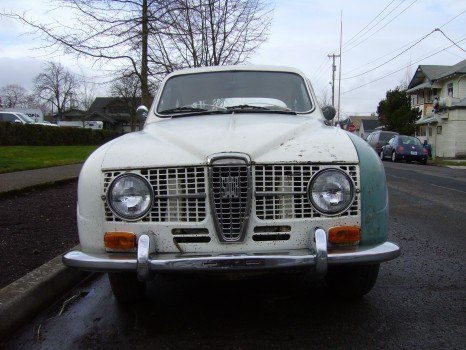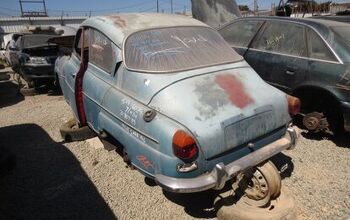Curbside Classics: 1968 Saab 96

It’s hard to look at this old Saab and not get choked up. And it’s not just because this once proud and spunky company is on the ropes. Old Saabs just have a way of stirring my emotions. This is going to be a Saab story.
The first time I encountered a Saab in Austria fifty years ago, I literally choked as an accelerating Swedish tourist engulfed me in a cloud of acrid blue exhaust from his two-stroke 93. But I was seduced (forever) by the purity of line on that svelte fastback as it gradually disappeared in its smoke screen.
Erik Carlsson’s ballsy victories in his red 96 over the big guys at Monte Carlo left me in awe. And the gutsy way a bunch of underemployed aeronautical engineers came up with the original 92 is inspirational. The vivid memories of time spent in my good friend’s identical 96 are sweet. But the “For Sale” sign on this one just makes me sad. Who could break up with a car like this? Waves of regret engulf me as I remember all the cars I sold and wish I hadn’t.
Enough emoting. Saab’s initial adoption of the two stroke engine was highly pragmatic: the tiny engine fit perfectly in front of the transaxle and its lightness engendered good handling. But original it wasn’t; the engine, drive train and the whole layout of the 92 was heavily cribbed from DKW, the mother of all zweitakter.
Two strokes engines may have been fairly common in Europe at the time, but they reeked of eccentricity stateside. Yet there were several 93s and 96s whose comings and goings I followed with interest after we moved to Iowa City in 1960. It was a university town, and Saab’s reputation as a college professor’s car was already well burnished. Curious, how did the same crowd that adopted these smoky cars as a badge of auto-intellectual superiority later become early Prius adopters? Atonement for prior sins?
In 1967, nascent environmental awareness (and the EPA) forced Saab to finally abandon the stinky two-stroke. Finding a suitable four-stroke to fit in the six-pack sized space where the little popcorn-popper had long resided was no small challenge. As luck would have it, Ford in Germany had an ultra-compact 60 degree V4; a Cologne V6 minus two cylinders. Forty years after this Saab’s V4 first coughed to life, Mustang and Explorer Cologne V6s are still rolling off that same transfer line. Think Ford has amortized this design by now?
Whereas a 60 degree V6 has a fairly high degree of harmonic and firing balance, cutting off two cylinders makes a V4 sound and feel exactly like . . . a V6 with two dead cylinders. A rougher and less even-firing engine would be hard to invent. Ironic too, considering how exceptionally smooth the little two-stroke had been. There was a good reason DKW and Auto-Union used the 3=6 slogan for their 3 cylinder two-strokes: they had the same number of power impulses and the smooth running characteristics of an inline six.
Nevertheless, the lumpy V4 was a good fit in the 96. And, unlike the two-stroke, it had a lusty torque curve, good mileage, a clean exhaust, and kept the Saab eccentricity quotient intact. Now I’ve always thought that the NSU or Mazda rotary would have been the perfect successor. It would have been a glove fit, and a rotary’s smooth running and off-throttle popping sounds almost like a two-stroke. There’s got to be one out there somewhere.
As Saab slides into its final coma, it’s both sad and amusing to hear of the heroic calls for its resuscitation (I’ve kept the emotions at bay long enough). Saab was a tiny European car maker, which along with so many others of its size, was long overdue to slip into the annals of history. Saab only created two unique platforms in its entire sixty year history: the 92 (93 & 96), and its replacement, the 99 (900) of 1969. It never once designed an original engine. And everything since the 900 was begged or borrowed: platforms from Fiat (9000), Lancia (600), and GM. Forget “Born from Jets”; try “Born from obsolete GM platforms.”
GM’s purchase of Saab was phenomenally stupid. There was nothing to suggest that they could bring lasting health and success to this then already moribund and broke marque. History has been harsh to smaller premium brands and the “rescue” of such (NSU by VW and Rover by BMW) were abject failures. Lancia is on perpetual life support by mother Fiat. But GM’s hubris was limitless, and there’s a sucker born every minute. Speaking of which, can I interest you in a well-used, slightly rusty 1968 Saab 96? It’s only $850, and I’m sure it’s got lots of life in it yet. Unlike its maker.

More by Paul Niedermeyer
Latest Car Reviews
Read moreLatest Product Reviews
Read moreRecent Comments
- Redapple2 Love the wheels
- Redapple2 Good luck to them. They used to make great cars. 510. 240Z, Sentra SE-R. Maxima. Frontier.
- Joe65688619 Under Ghosn they went through the same short-term bottom-line thinking that GM did in the 80s/90s, and they have not recovered say, to their heyday in the 50s and 60s in terms of market share and innovation. Poor design decisions (a CVT in their front-wheel drive "4-Door Sports Car", model overlap in a poorly performing segment (they never needed the Altima AND the Maxima...what they needed was one vehicle with different drivetrain, including hybrid, to compete with the Accord/Camry, and decontenting their vehicles: My 2012 QX56 (I know, not a Nissan, but the same holds for the Armada) had power rear windows in the cargo area that could vent, a glass hatch on the back door that could be opened separate from the whole liftgate (in such a tall vehicle, kinda essential if you have it in a garage and want to load the trunk without having to open the garage door to make room for the lift gate), a nice driver's side folding armrest, and a few other quality-of-life details absent from my 2018 QX80. In a competitive market this attention to detai is can be the differentiator that sell cars. Now they are caught in the middle of the market, competing more with Hyundai and Kia and selling discounted vehicles near the same price points, but losing money on them. They invested also invested a lot in niche platforms. The Leaf was one of the first full EVs, but never really evolved. They misjudged the market - luxury EVs are selling, small budget models not so much. Variable compression engines offering little in terms of real-world power or tech, let a lot of complexity that is leading to higher failure rates. Aside from the Z and GT-R (low volume models), not much forced induction (whether your a fan or not, look at what Honda did with the CR-V and Acura RDX - same chassis, slap a turbo on it, make it nicer inside, and now you can sell it as a semi-premium brand with higher markup). That said, I do believe they retain the technical and engineering capability to do far better. About time management realized they need to make smarter investments and understand their markets better.
- Kwik_Shift_Pro4X Off-road fluff on vehicles that should not be off road needs to die.
- Kwik_Shift_Pro4X Saw this posted on social media; “Just bought a 2023 Tundra with the 14" screen. Let my son borrow it for the afternoon, he connected his phone to listen to his iTunes.The next day my insurance company raised my rates and added my son to my policy. The email said that a private company showed that my son drove the vehicle. He already had his own vehicle that he was insuring.My insurance company demanded he give all his insurance info and some private info for proof. He declined for privacy reasons and my insurance cancelled my policy.These new vehicles with their tech are on condition that we give up our privacy to enter their world. It's not worth it people.”






































Comments
Join the conversation
These Saabs were great, I always regretted not aqcuiring one. Hard to find a good one now. This one is kind of shabby looking: it doesn't show off the beautifully unique design; its crying out for a makeover.
I swear I think I saw this car last weekend, north of Chicago. I'm serious, I'd be happy to tell you all about the thrilling encounter, and I even took a photo. (Unless they all had green driver's-side front fenders, that is.)